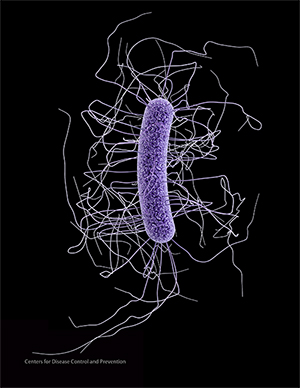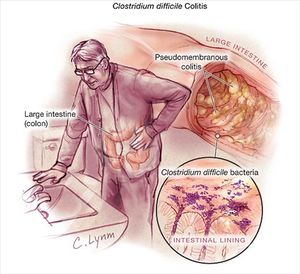The Increasing Prevalence of Clostridium Difficile in North America: Difference between revisions
No edit summary |
No edit summary |
||
| Line 39: | Line 39: | ||
<br> | <br> | ||
[[Image: | [[Image: CDiffSpores.jpg|thumb|300px|right|How <i>Clostridium Difficile</i> affects the body. Credit to [http://www.bactaclean.co.uk/c-diff-disease/ Envirosystems].]] | ||
Revision as of 15:24, 24 April 2017
Section

By Aly Palia
Clostridium difficile infection, or CDI, has become more prevalent through both the United States and Canada in recent years. The infection is spread by spores of the bacteria Clostridium difficile, also known as C. diff. The bacteria themselves are very common in the soil and can be found in the human intestine. In fact, C. difficile exists in around 2-5% of the adult population [1]. When they are in a stressful environment, the bacteria will produce spores that can tolerate more extreme conditions than the bacteria themselves. The bacteria become pathogenic when these spores are produced in the human gut. The spores contain toxins, such as enterotoxin (Clostridium difficile toxin A) and cytotoxin (Clostridium difficile toxin B). Patients with these spores can have diarrhea and inflammation in the body. While the majority of the infections from C. diff can be treated with antibiotics, there are some strains that are increasing in their antibiotic resistance [2]. Thus, many patients with CDIs aren’t able to receive adequate treatment for their infections, so many cases are becoming more severe.
At right is a sample image insertion. It works for any image uploaded anywhere to MicrobeWiki.
The insertion code consists of:
Double brackets: [[
Filename: PHIL_1181_lores.jpg
Thumbnail status: |thumb|
Pixel size: |300px|
Placement on page: |right|
Legend/credit: Electron micrograph of the Ebola Zaire virus. This was the first photo ever taken of the virus, on 10/13/1976. By Dr. F.A. Murphy, now at U.C. Davis, then at the CDC.
Closed double brackets: ]]
Other examples:
Bold
Italic
Subscript: H2O
Superscript: Fe3+
Introduce the topic of your paper. What is your research question? What experiments have addressed your question? Applications for medicine and/or environment?
Sample citations: [3]
[4]
A citation code consists of a hyperlinked reference within "ref" begin and end codes.
Bacteria and Spores
Include some current research, with at least one figure showing data.
Every point of information REQUIRES CITATION using the citation tool shown above.
Risk Factors and Transmission
Include some current research, with at least one figure showing data.
Symptoms
Include some current research, with at least one figure showing data.

Treatments
Conclusion
Increasing Prevalence
References
- ↑ Ryan KJ, Ray CG (2004). Sherris Medical Microbiology (4th ed.). McGraw Hill. 322-4.
- ↑ [http://www.emedicinehealth.com/clostridium_difficile_c_difficile_c_diff/article_em.htm=PDF Nabili, Siamak N. "Clostridium Difficile." EMedicineHealth. Ed. Melissa Conrad Stoppler and Bhupinder Anand. N.p., 26 June 2016. Web. 17 Apr. 2017.
- ↑ Hodgkin, J. and Partridge, F.A. "Caenorhabditis elegans meets microsporidia: the nematode killers from Paris." 2008. PLoS Biology 6:2634-2637.
- ↑ Bartlett et al.: Oncolytic viruses as therapeutic cancer vaccines. Molecular Cancer 2013 12:103.
Authored for BIOL 238 Microbiology, taught by Joan Slonczewski, 2017, Kenyon College.
